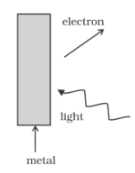Question:
Consider the figure given for photoemission. How would you reconcile with momentum-conservation? Note light (photons) have momentum in a different direction than the emitted electrons.

Solution:
When the photons strike the metal surface, there is a transfer of momentum to the atoms on the metal surface which results in a decrease in speed of the photons. The
momentum of photons is transferred to the nucleus and electrons on the metal surface. The electrons emitted are in the opposite direction that of the photons.
Nevertheless, the total momentum transferred by the photons and electrons will be equal.
Click here to get exam-ready with eSaral
For making your preparation journey smoother of JEE, NEET and Class 8 to 10, grab our app now.
